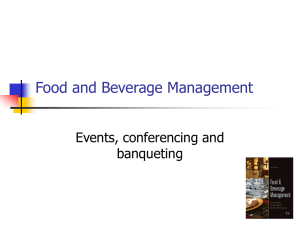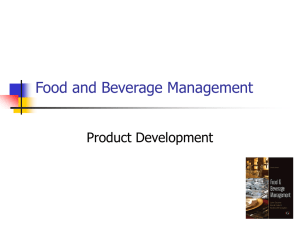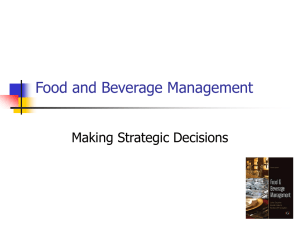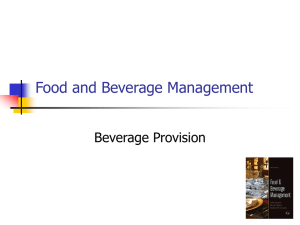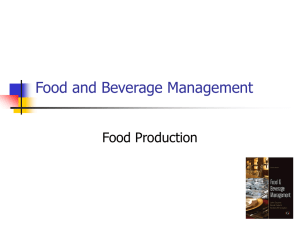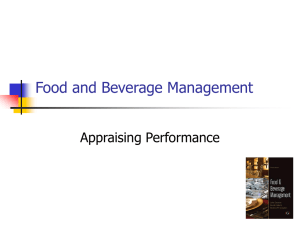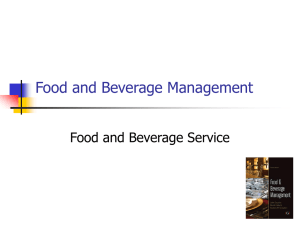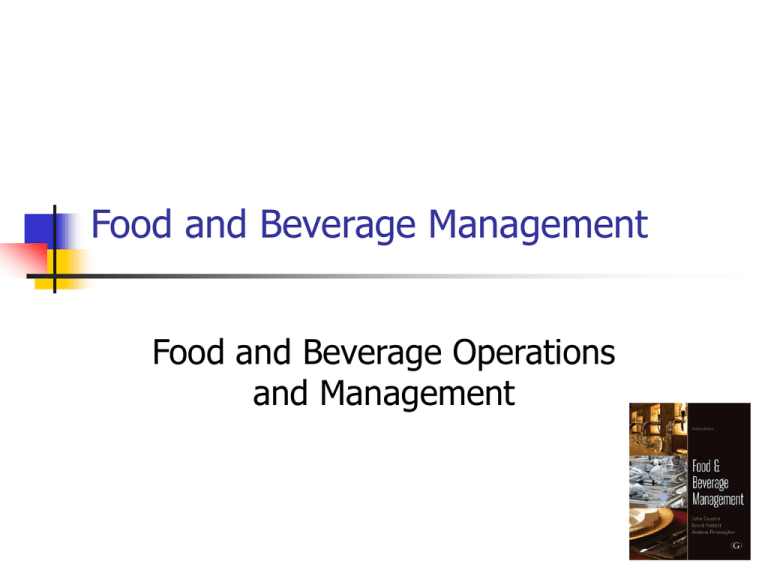
Food and Beverage Management
Food and Beverage Operations
and Management
Food and beverages
Food: includes a wide range of styles
and cuisine types
Beverages: includes all alcoholic and
non-alcoholic drinks, cold and hot
© 2011 Cousins et al: Food and Beverage Management, 3rd edition, Goodfellows Publishers
The foodservice cycle
© 2011 Cousins et al: Food and Beverage Management, 3rd edition, Goodfellows Publishers
The foodservice cycle
Can be used as a basis (framework) to
analyse and compare different
foodservice operations
Can be used to help understand how an
individual operation works:
Difficulties in one element of the cycle will cause
difficulties in the elements that follow
Difficulties experienced in one element of the cycle
will have their causes in preceding elements
© 2011 Cousins et al: Food and Beverage Management, 3rd edition, Goodfellows Publishers
Structure of the book
Based on the foodservice cycle
© 2011 Cousins et al: Food and Beverage Management, 3rd edition, Goodfellows Publishers
Systems approach
Two dimensions:
Systematic approach to the design,
planning and control of a food and
beverage operation
The management of the operating systems
within a food and beverage operation
© 2011 Cousins et al: Food and Beverage Management, 3rd edition, Goodfellows Publishers
Comparison of traditional and
systems approaches
© 2011 Cousins et al: Food and Beverage Management, 3rd edition, Goodfellows Publishers
Management of operations
Concerned with:
The management of materials
The management of information
The management of people (customers)
© 2011 Cousins et al: Food and Beverage Management, 3rd edition, Goodfellows Publishers
Four systems for foodservice
1.
2.
3.
4.
Food production
Beverage provision
Delivery or the ‘service sequence’
Customer management or the
‘customer process’
© 2011 Cousins et al: Food and Beverage Management, 3rd edition, Goodfellows Publishers
Interrelationship
of the four
systems of a
food service
operation
© 2011 Cousins et al: Food and Beverage Management, 3rd edition, Goodfellows Publishers
Dimensions of the hospitality
industry’s product
1.
2.
3.
4.
5.
6.
7.
8.
Intangibility
Perishability
Variability of output
Simultaneous production and consumption
Ease of duplication
Heterogeneity
Demand variation
Difficulty of comparison
© 2011 Cousins et al: Food and Beverage Management, 3rd edition, Goodfellows Publishers
Sectors of the industry
Hotels and other tourist accommodation
Restaurants, popular catering, fast food, takeaway
Retail stores
Events/banqueting/conferencing/exhibitions
Leisure attractions
Motorway service stations
Industrial catering
Welfare catering
Licensed trade
Transport catering
Outdoor catering (off-premises catering)
© 2011 Cousins et al: Food and Beverage Management, 3rd edition, Goodfellows Publishers
Variables in foodservice sectors
Historical background
Reasons for customer demand
Size of sector
Policies: financial, marketing, catering
Interpretation of demand/catering concept
Technological development
Influences / State of sector development
Primary/secondary activity
Types of outlets
Profit orientation/cost provision
Public/private ownership
© 2011 Cousins et al: Food and Beverage Management, 3rd edition, Goodfellows Publishers
Profit and cost markets
Profit market - includes hotels,
commercial restaurants, pubs, fast food
and leisure outlets
Cost market - includes catering in
business and industry, education,
healthcare and the armed forces
© 2011 Cousins et al: Food and Beverage Management, 3rd edition, Goodfellows Publishers
Summary of foodservice sectors
© 2011 Cousins et al: Food and Beverage Management, 3rd edition, Goodfellows Publishers
Types of market
General market
Non-captive: customers have a full choice
Restricted market
Captive: customers have no choice
Semi-captive: customers have a choice
before choosing but then have little choice
of food and drink other than that on offer
© 2011 Cousins et al: Food and Beverage Management, 3rd edition, Goodfellows Publishers
Customer is central
To the process and as an active
participant within it
Understanding the customer is critical
to the business success of foodservice
operations
© 2011 Cousins et al: Food and Beverage Management, 3rd edition, Goodfellows Publishers
Different foodservice operations
Are designed for the:
Needs people have at a particular time
Rather than for the type of people they are
The same customer can:
Be business customer during the week
A member of a family at the weekend
Wanting a quick lunch or snack while travelling
Be organising a special event
© 2011 Cousins et al: Food and Beverage Management, 3rd edition, Goodfellows Publishers
Main aim
To achieve customer satisfaction
By meeting the customers’ needs:
Physiological
Economic
Social
Psychological
Convenience
Customers may want to satisfy some
or all of these needs
© 2011 Cousins et al: Food and Beverage Management, 3rd edition, Goodfellows Publishers
Reasons for a customer’s choice:
Often determine the customer’s
satisfaction or dissatisfaction
Dissatisfaction can come from:
Aspects of the food and beverage
operation
Aspects beyond the operation’s control
Either way the operation has to deal
with it
© 2011 Cousins et al: Food and Beverage Management, 3rd edition, Goodfellows Publishers
Potential dissatisfactions
Controllable by the establishment
e.g. scruffy, unhelpful staff, cramped conditions
Uncontrollable
e.g. behaviour of other customers, the weather,
transport problems
© 2011 Cousins et al: Food and Beverage Management, 3rd edition, Goodfellows Publishers
Product augmentation
The core of the product
The food and drink provision
The tangible elements of the product
The methods of delivery
Augmentation of the product
Takes into account the complete package
Competition mostly takes place at the
augmented level
© 2011 Cousins et al: Food and Beverage Management, 3rd edition, Goodfellows Publishers
Reasons for eating out
Convenience
Variety
Labour
Status
Culture / tradition
Impulse
No choice
© 2011 Cousins et al: Food and Beverage Management, 3rd edition, Goodfellows Publishers
Meal experience factors
Food and drink on offer
Level of service
Level of cleanliness and hygiene
Perceived value for money and price
Atmosphere of the establishment
© 2011 Cousins et al: Food and Beverage Management, 3rd edition, Goodfellows Publishers
The business environment
P
E
S
T
L
E
Political
Economic
Socio-cultural
Technological
Legal
Ecological
© 2011 Cousins et al: Food and Beverage Management, 3rd edition, Goodfellows Publishers
Key influences
Social trends/lifestyle
Amount of disposable income
Inflation/stagnation
Available credit
Cultural factors
Regulation – taxation, VAT, tourism
Media – television, advertising,
magazines, celebrity chefs
© 2011 Cousins et al: Food and Beverage Management, 3rd edition, Goodfellows Publishers
The micro-environment
Porter’s Five Forces
Adapted from Porter 2004
© 2011 Cousins et al: Food and Beverage Management, 3rd edition, Goodfellows Publishers
Legal framework includes:
Health, safety and security
Licensing framework
Selling goods by weights ad measures
Contracts
Selling good by description
Avoiding discrimination
Providing services
Customer property and customer debt
Data protection
© 2011 Cousins et al: Food and Beverage Management, 3rd edition, Goodfellows Publishers
Important of compliance
Penalties for non-compliance can be
severe, both for the business and for
the management and staff
Important that all members of staff
contribute to ensuring compliance
© 2011 Cousins et al: Food and Beverage Management, 3rd edition, Goodfellows Publishers
Health, safety and security
Duty to care for all staff and lawful
visitors and must not:
Sell (or keep for sale) food and beverages
that are unfit for people to eat
Cause food or beverages to be dangerous to
health
Sell food or beverages that are not what the
customer is entitled to expect, in terms of
content or quality
Describe or present food in a way that is
false or misleading
© 2011 Cousins et al: Food and Beverage Management, 3rd edition, Goodfellows Publishers
Health, safety and security
A foodservice operator must be able to
demonstrate that steps have been
taken to ensure good food hygiene (due
diligence)
© 2011 Cousins et al: Food and Beverage Management, 3rd edition, Goodfellows Publishers
Licensing framework
Four key objectives:
1.
2.
3.
4.
the prevention of crime and disorder
public safety
the prevention of public nuisance
the protection of children from harm
© 2011 Cousins et al: Food and Beverage Management, 3rd edition, Goodfellows Publishers
Requirements include:
Display of a summary of the premises licence
Drinks price lists to be displayed
Restrictions on under-aged persons being
served alcohol and employed to serve alcohol
The need for an authorised person (or the
personal licence holder) to be on site at all
times
© 2011 Cousins et al: Food and Beverage Management, 3rd edition, Goodfellows Publishers
Other types of licences include:
Music (live or pre-recorded)
Dancing
Gambling
Theatrical performance and television
display
Supervisor and the staff should be
aware of the provisions and limitations
of the licences to ensure compliance
© 2011 Cousins et al: Food and Beverage Management, 3rd edition, Goodfellows Publishers
Selling goods by weights and
measures
Generally requires
Display of the prices and the measures
used for all alcohol served
The food and beverage items for sale to be
of the quantity and quality demanded by
the customer
The use of officially stamped measures
© 2011 Cousins et al: Food and Beverage Management, 3rd edition, Goodfellows Publishers
Contract
Made when one party agrees to the
terms of an offer made by another
party; this can be written or verbal
All foodservice establishments should
be clear on:
circumstances where the operation may
seek compensation from the customer
taking care when dealing with minors
(persons under 18)
© 2011 Cousins et al: Food and Beverage Management, 3rd edition, Goodfellows Publishers
Selling goods by description
All food, beverages and other services
provided must be:
fit for purpose and of satisfactory quality in
relation to price and description
accurately described in terms of size, quality,
composition, production, quantity and standard
© 2011 Cousins et al: Food and Beverage Management, 3rd edition, Goodfellows Publishers
And:
All statements of price must be clear
and accurate
Food, beverages and other services
correspond to their description
Times, dates, locations and nature of
service are as promised
Billing is fair, transparent and reflects
the prices quoted
© 2011 Cousins et al: Food and Beverage Management, 3rd edition, Goodfellows Publishers
To ensure compliance:
Take care when:
wording menus and wine lists
describing items to customers
stating if prices include local and/or
government taxes
describing conditions such as cover
charges, service charges or extras
describing the service provision
© 2011 Cousins et al: Food and Beverage Management, 3rd edition, Goodfellows Publishers
Avoiding discrimination
Acts relating to discrimination on
grounds of ethnic origin, race, creed,
sex or disability
Three types of discrimination:
Direct discrimination
Indirect discrimination
Discrimination through victimisation
© 2011 Cousins et al: Food and Beverage Management, 3rd edition, Goodfellows Publishers
Providing services
Generally no specific requirement to
serve anyone
Important to be aware of:
Circumstances where there may be a
mandatory requirement to provide services
Valid reasons for refusal
© 2011 Cousins et al: Food and Beverage Management, 3rd edition, Goodfellows Publishers
Customer property and debt
Good practice to ensure:
care is taken of customers’ property in
order to minimise potential loss or damage
clear guidance on the procedures to follow
if the customer is unable or unwilling to
pay
© 2011 Cousins et al: Food and Beverage Management, 3rd edition, Goodfellows Publishers
Data protection
Customers right to expect that data about
them is:
kept secure
only used for the published business purposes
Operations must ensure data is:
Kept up to date, fairly, lawfully and securely
Not passed on to third parties without prior
consent
And that staff are aware of required procedures
© 2011 Cousins et al: Food and Beverage Management, 3rd edition, Goodfellows Publishers

